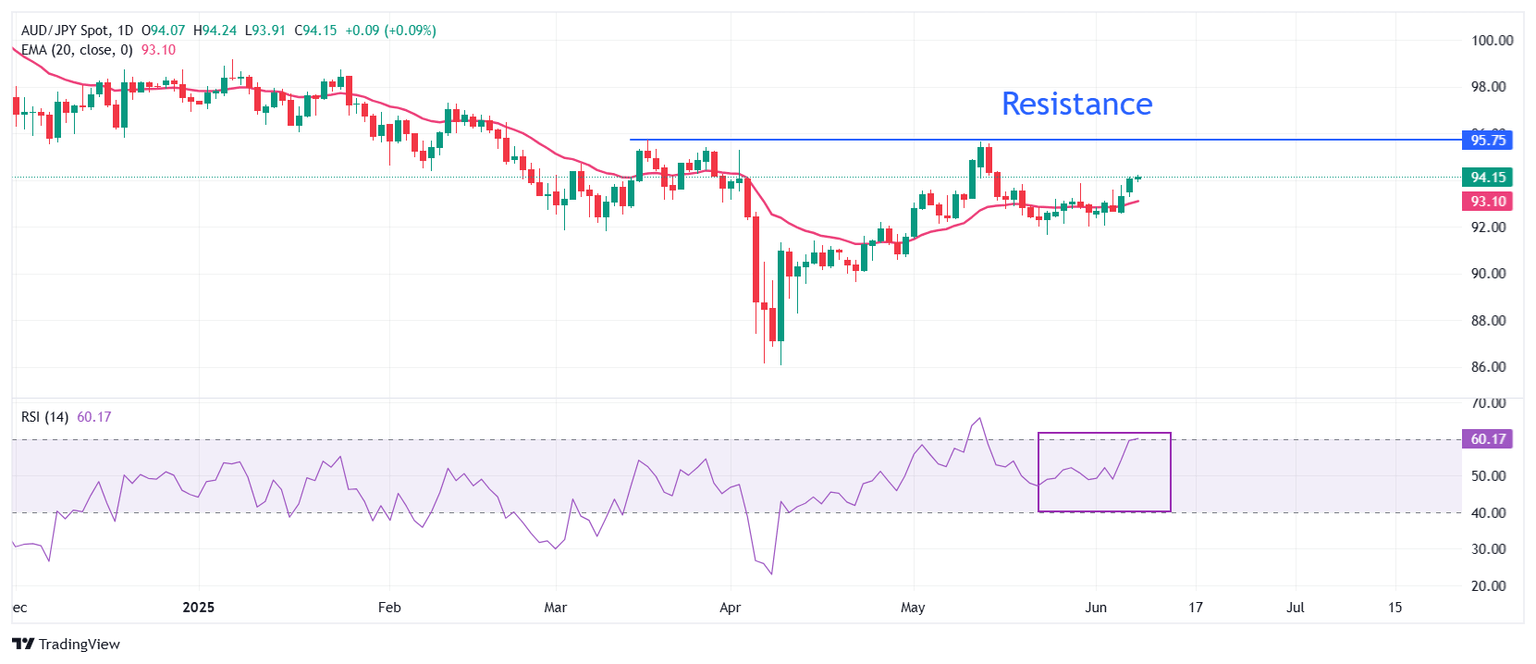AUD/JPY Price Forecast: Aims to revisit over three-month high around 95.70
- AUD/JPY holds onto gains near 94.10 ahead of Sino-US trade discussions.
- The RBA is expected to reduce interest rates in the policy meeting next month.
- The upwardly revised Japan’s Q1 GDP data has offered support to the Japanese Yen.

The AUD/JPY pair clings to gains near a fresh three-week high around 94.10 during European trading hours on Monday. The pair trades firmly as antipodeans outperform across the board ahead of trade discussions between the United States (US) and China in London during the day.
Australian Dollar PRICE Today
The table below shows the percentage change of Australian Dollar (AUD) against listed major currencies today. Australian Dollar was the strongest against the US Dollar.
| USD | EUR | GBP | JPY | CAD | AUD | NZD | CHF | |
|---|---|---|---|---|---|---|---|---|
| USD | -0.18% | -0.23% | -0.38% | -0.11% | -0.41% | -0.59% | -0.13% | |
| EUR | 0.18% | -0.07% | -0.21% | 0.06% | -0.19% | -0.42% | 0.04% | |
| GBP | 0.23% | 0.07% | -0.06% | 0.13% | -0.14% | -0.36% | 0.11% | |
| JPY | 0.38% | 0.21% | 0.06% | 0.28% | -0.09% | -0.28% | 0.13% | |
| CAD | 0.11% | -0.06% | -0.13% | -0.28% | -0.33% | -0.49% | -0.02% | |
| AUD | 0.41% | 0.19% | 0.14% | 0.09% | 0.33% | -0.20% | 0.25% | |
| NZD | 0.59% | 0.42% | 0.36% | 0.28% | 0.49% | 0.20% | 0.46% | |
| CHF | 0.13% | -0.04% | -0.11% | -0.13% | 0.02% | -0.25% | -0.46% |
The heat map shows percentage changes of major currencies against each other. The base currency is picked from the left column, while the quote currency is picked from the top row. For example, if you pick the Australian Dollar from the left column and move along the horizontal line to the US Dollar, the percentage change displayed in the box will represent AUD (base)/USD (quote).
The impact of the Sino-US trade talks outcome is expected to be significant on the Australian Dollar (AUD), given Australia’s strong dependence on its exports to China.
On the domestic front, market experts believe that the Reserve Bank of Australia (RBA) could reduce interest rates for the third straight time by 25 basis points (bps) to 3.85%.
Though investors have underpinned the Australian Dollar against the Japanese Yen (JPY), the latter is outperforming its other peers on the back of an upward revision in the Q1 Gross Domestic Product (GDP) data.
Japanese Cabinet Office reported that the economy remained flat in the January-March period, compared to a 0.2% decline shown in the preliminary estimates.
AUD/JPY strives to extend its two-day winning streak at the start of the week. The cross holds the 20-day Exponential Moving Average (EMA), indicating a bullish near-term trend.
The 14-day Relative Strength Index (RSI) rises to near 60.00. A fresh bullish momentum would emerge if the RSI breaks above that level.
The pair could revisit the March 18 high of 95.70 and extend its upside beyond that towards the February 19 high of 96.77 if it manages to break above the May 15 high of 94.37.
In an alternate scenario, a downside move by the pair below the May 23 low of 91.65 could expose it to the April 29 low of 90.60, followed by the psychological level of 90.00.
AUD/JPY daily chart

Japanese Yen FAQs
The Japanese Yen (JPY) is one of the world’s most traded currencies. Its value is broadly determined by the performance of the Japanese economy, but more specifically by the Bank of Japan’s policy, the differential between Japanese and US bond yields, or risk sentiment among traders, among other factors.
One of the Bank of Japan’s mandates is currency control, so its moves are key for the Yen. The BoJ has directly intervened in currency markets sometimes, generally to lower the value of the Yen, although it refrains from doing it often due to political concerns of its main trading partners. The BoJ ultra-loose monetary policy between 2013 and 2024 caused the Yen to depreciate against its main currency peers due to an increasing policy divergence between the Bank of Japan and other main central banks. More recently, the gradually unwinding of this ultra-loose policy has given some support to the Yen.
Over the last decade, the BoJ’s stance of sticking to ultra-loose monetary policy has led to a widening policy divergence with other central banks, particularly with the US Federal Reserve. This supported a widening of the differential between the 10-year US and Japanese bonds, which favored the US Dollar against the Japanese Yen. The BoJ decision in 2024 to gradually abandon the ultra-loose policy, coupled with interest-rate cuts in other major central banks, is narrowing this differential.
The Japanese Yen is often seen as a safe-haven investment. This means that in times of market stress, investors are more likely to put their money in the Japanese currency due to its supposed reliability and stability. Turbulent times are likely to strengthen the Yen’s value against other currencies seen as more risky to invest in.
indicating a bullish near-term trend
Author

Sagar Dua
FXStreet
Sagar Dua is associated with the financial markets from his college days. Along with pursuing post-graduation in Commerce in 2014, he started his markets training with chart analysis.

















